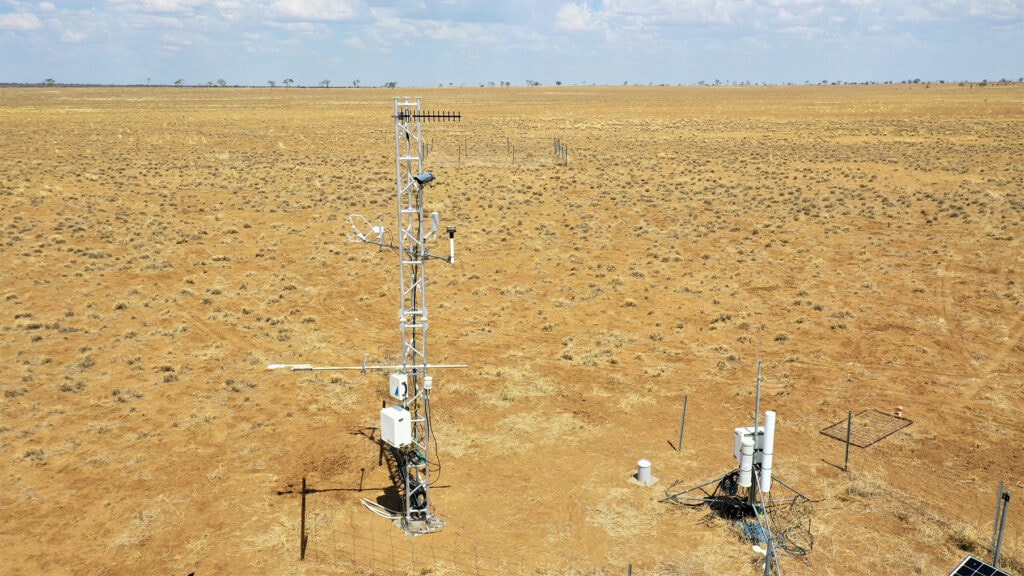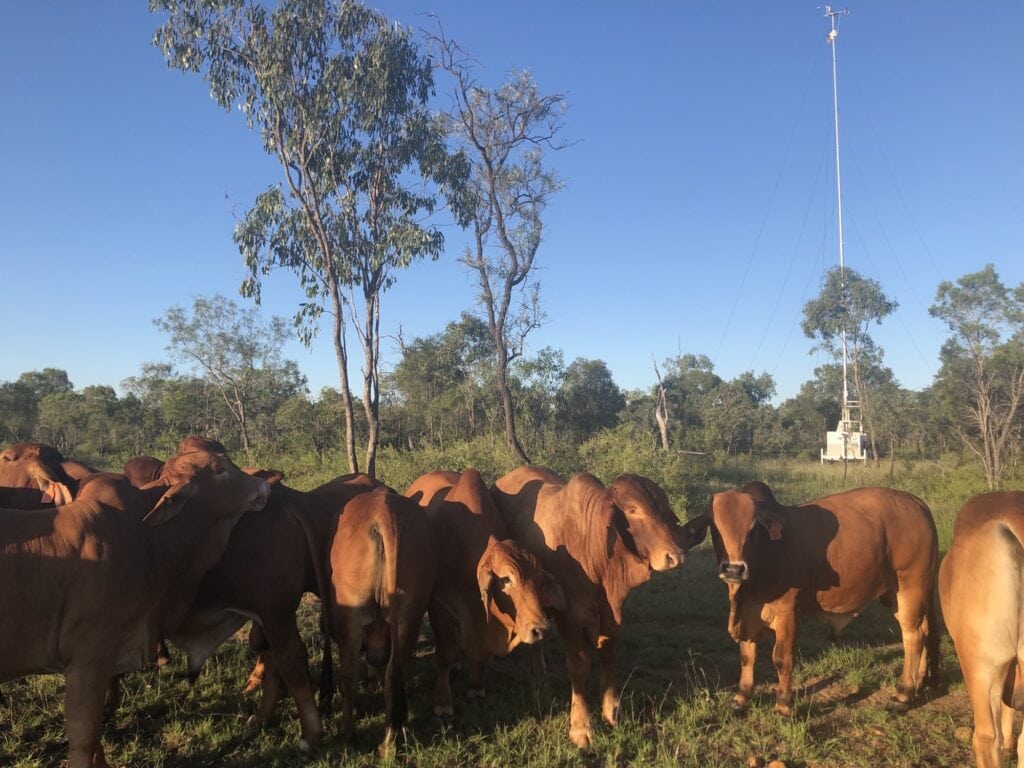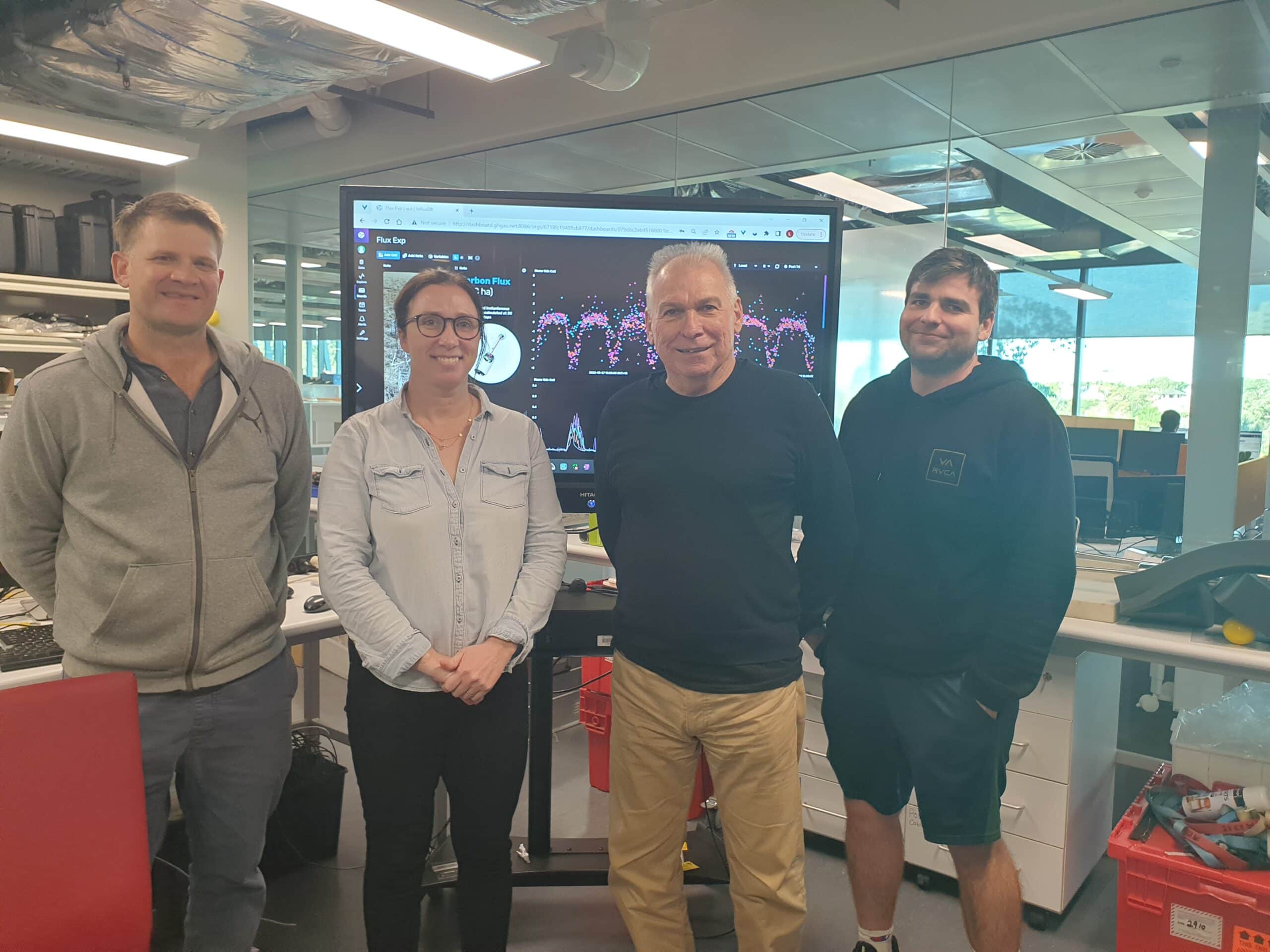L-R. Associate Professor David Rowlings, Dr Elaine Mitchell, Professor Peter Grace and Dr Liam Grace at QUT showing live flux data collected as part of the soil carbon sequestration project.
TERN is supporting an industry-funded Queensland University of Technology study about improving soil carbon-sequestration models. The study has already yielded new grazing strategies that make a difference.
Agricultural soil ecosystems can play a hitherto under-appreciated role in carbon-sequestration. All plants – whether humble pasture grass or a mighty tree – use carbon dioxide in their growth, which they take from the atmosphere. When the plant dies and decomposes, around twenty percent of its carbon is incorporated into the soil, via the soil carbon cycle. Carbon stored this way can persist for long periods. According to Professor Peter Grace of Queensland University of Technology (QUT), agricultural soils could sequester a significant amount, approximately ten percent, of the world’s carbon emissions.
Maximising soil carbon storage
While not all agricultural soil ecosystems live up to this potential, improved management could help the soils substantially increase their carbon storage capacity. To study this in further detail, Professor Grace and Associate Professor David Rowlings, also of QUT, are conducting a study, in association with TERN, to refine and validate the scientific models of the soil carbon cycle. This will help devise improved management practices for farmers.
The first phase of the project started in 2020 and will run until 2025. The study is primarily supported by Meat and Livestock Australia, AgriMix Pastures, McDonald’s, TurOSI and Rabobank. Its objective is to support organisations interested in developing carbon-neutral meat products and potentially accessing the global carbon credit market. The study focuses on grazing land in central and southern Queensland and northern New South Wales. These regions are rich in clay soils, which have the greatest potential for storing carbon. The areas also receive high rainfall, ensuring reliable plant growth, which is the primary source of soil organic carbon.
Scientific models, which are mathematical approximations of terrestrial ecosystems, allow for simulation and prediction of carbon and nutrient flows. “Soil carbon dynamics is actually pretty simple,” says Professor Grace. “We know pretty well how much carbon can be left behind by the soil microbes that consume the plant biomass. What we don’t understand as well is how do you manipulate soils, or the plants that are in the soils, to get the maximum amount of carbon sequestered and to ensure it persists.”
The models will reproduce what is happening in the field in terms of plant uptake, soil carbon cycling, emissions to the atmosphere, and all biogeochemical factors affecting these processes. The study will calibrate and validate the models, making them more accurate for a wide range of conditions..
New remote study methods
The traditional way of assessing soil carbon is to dig lots of holes and collect many samples for analysis. Such assessment over a large area would be expensive and impractical. Instead, this study uses data from flux towers.
TERN and the OzFlux research network maintain numerous eddy co-variance flux stations around Australia to continuously monitor changes in carbon and water vapour related to specific ecosystems. The instruments on the TERN-OzFlux stations very accurately measure gaseous exchange between the soil, plants and atmosphere, second by second. In this case, carbon dioxide is the gas of greatest interest.
This project uses two TERN flux stations set up in pasture ecosystems, and fifteen similar towers funded by the industry partnership with QUT. “The high temporal frequency data from the flux stations lets us calibrate our models with great accuracy,” adds Professor Grace. “We then use soil data from long-term sites to validate our models, thus ensuring a robust solution”

Practical management suggestions
Accurate calibration and validation of the models yields a clear understanding of processes and effects, and that can suggest practical management applications. The TERN/QUT study is testing two main strategies that farmers can adopt.
The first concerns the benefits of a certain tropical legume, Desmanthus, as a pasture species. Cattle produce less methane as a metabolic by-product of their digestion when they consume Desmanthus. Methane has an even greater greenhouse effect than carbon dioxide and reducing methane production is significant for the mitigation of global warming. The study team is working with industry to show the additional benefits of Desmanthus in terms of biomass production and soil carbon sequestration.
A second practical outcome of the study concerns rotational grazing. The modern method of running cattle is to let them graze a paddock for a controlled period of time based on available feed budgeting, then to rotate them into a new paddock. This lets the soil recover and ensures optimum ground cover, which produces more pasture and more root material, meaning more carbon sequestered into the soil. The soil-carbon models quantify the processes at work, enabling a farmer to know when to move the cattle.
The management practices to emerge from this study address both levels of farmers’ motivation. In short, tactics that are good for mitigating global warming are both productive and profitable. Increasing soil carbon also improves its nutrient content. Nutrient-rich soils are healthier, more productive and more resilient to climate change and variability. For example, carbon-rich soil holds water like a sponge, which can mean the difference between a pasture making it through the next drought or not. Carbon content is a good indicator of soil health and condition generally. Both productivity and resilience mean greater profits for farmers.
Apart from using soil carbon to mitigate climate change, soil carbon models also predict how the ecosystem will respond to climate change. For Australia, climate change might mean more heatwaves and droughts, and these conditions lose carbon. So, knowing how ecosystems are likely to respond is another important consideration in the development of grazing-management practices.
According to Professor Grace, TERN has high-level expertise and a record of achievement in natural and managed systems monitoring. He says this project shows TERN extending more into agricultural areas and making a difference there. “TERN provides the ideal infrastructure,” he says, “both hardware and computational software, to bring all that experience and capability together.”








